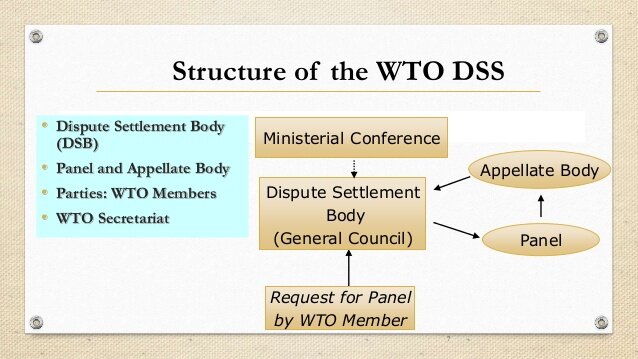Indian Economy
Issues in WTO’s Dispute Resolution Mechanism
The World Trade Organization’s (WTO) dispute settlement mechanism is going through a crisis. The body is struggling to appoint new members to its understaffed Appellate Body that hears appeals in trade.
Over 20 developing countries met in New Delhi on 13-14 May 2019 to discuss the ways to prevent the WTO’s dispute resolution system from collapsing due to the logjam in the appointments.
WTO’s Appellate Body
- The Appellate Body, set up in 1995, is a standing committee of seven members that presides over appeals against judgments passed in trade-related disputes brought by WTO members.
- Countries involved in a dispute over measures purported to break a WTO agreement or obligation can approach the Appellate Body if they feel the report of the panel set up to examine the issue needs to be reviewed on points of law.
- However, existing evidence is not re-examined but legal interpretations are reviewed.
- The Appellate Body can uphold, modify, or reverse the legal findings of the panel that heard the dispute. Countries on either or both sides of the dispute can appeal.
- The Appellate Body has so far issued 152 reports. The reports, once adopted by the WTO’s dispute settlement body, are final and binding on the parties.
Issues in WTO’s Appellate Body
- Over the last few years, the membership of the body has shriveled to just three persons instead of the required seven.
- This is because the United States, which believes the WTO is biased against it, has been blocking appointments of new members and reappointments of some members who have completed their four-year tenure.
- Two members will complete their tenures in December 2019, leaving the body with just one member.
- At least three people are required to preside over an appeal, and if new members are not appointed to replace the two retiring ones, the body will cease to be relevant.
- The understaffed appeals body has been unable to stick to its 3 month deadline for appeals filed in the last few years, and the backlog of cases has prevented it from initiating proceedings in appeals that have been filed in the last year.
India’s Disputes in WTO
- India has so far been a direct participant in 54 disputes, and has been involved in 158 as a third party.
- In February 2019, the body said it would be unable to staff an appeal in a dispute between Japan and India over certain safeguard measures that India had imposed on imports of iron and steel products.
NOTE: The dispute panel (India and Japan) had found that India had acted “inconsistently” with some WTO agreements, and India had notified the Dispute Settlement Body of its decision to appeal certain issues of law and legal interpretations in December 2018.
Implications
- With the Appellate Body unable to review new applications, there is already great uncertainty over the WTO’s dispute settlement process.
- If the body is declared non-functional in December, countries may be compelled to implement rulings by the panel even if they feel that gross errors have been committed.
- Countries may refuse to comply with the order of the panel on the ground that it has no avenue for appeal. It will run the risk of facing arbitration proceedings initiated by the other party in the dispute.
- This also does not bode well for India, which is facing a rising number of dispute cases, especially on agricultural products.
- In the backdrop of rising trade tension between the US and China, the overall weakening of the WTO framework could have the effect of undoing over two decades of efforts to avoid protectionism in global trade.
Way Forward
- Usually, new appointments to the Appellate Body are made by a consensus of WTO members, but there is also a provision for voting where a consensus is not possible.
- The group of 17 least developed and developing countries, including India, that have committed to working together to end the impasse at the Appellate Body can submit or support a proposal to this effect, and try to get new members on the Appellate Body by a majority vote.
- But, this may be an option of the last resort, as all countries fear unilateral measures by the US as a consequence of directly opposing its veto.
Indian Polity
'State' Under Article 12 of the Constitution
Recently Delhi High Court has given judgement in Sanjaya Bahel v. Union of India & Others case, that the United Nations is not a "State" within the meaning of Article 12 of the Constitution of India and is not amenable to the jurisdiction of the Court under Article 226 of the Constitution of India.
- The court says, by no stretch of the imagination an organisation of the United Nations which is an international body be treated as "instrumentality" and or an "agency" of the Government."
- Part III of our constitution consists of a long list of fundamental rights, it starts right from Article 12 to Article 35.
- The purpose behind having our fundamental rights rests in the need for having a just society i.e a nation ruled by law and not by a tyrant.
- With great power comes a greater risk of abuse and in order to safeguard the rights and freedom of individuals it needs constitutional protection from the acts of the state itself.
- However, in order to delve deeper into the concept, it is firstly imperative to explore the definition of “state”.
Article 12 defines the state in the following manner
- In this part, unless the context otherwise requires, "the State" includes the Government and Parliament of India and the Government and the Legislature of each of the States and all local or other authorities within the territory of India or under the control of the Government of India.
- Dispute and discussion: around phrase of Article 12 i.e “other authorities”, which has evolved over time:
- Earlier, a restrictive interpretation was given to this term, i.e, the authorities exercising governmental or sovereign function would only be covered under other authorities.
- The liberal interpretation says that it is not necessary for an authority to be engaged in sovereign or governmental function to come under the definition of the state. The bodies like State Electricity Board, LIC, ONGC and IFC also come under “other authorities”.
- In R.D Shetty v. Airport Authority of India Justice P.N Bhagwati gave 5 Point test This is a test to determine whether a body is an agency or instrumentality of the state and goes as follows –
- Financial resources of the State, where State is the chief funding source i.e. the entire share capital is held by the government.
- Deep and pervasive control of the State
- The functional character being Governmental in its essence, meaning thereby that its functions have public importance or are of a governmental character.
- A department of Government transferred to a corporation.
- Enjoys “monopoly status” which State conferred or is protected by it.
This was elucidated with the statement that the test is only illustrative and not conclusive in its nature and is to be approached with great care and caution.
Judiciary
- The Judiciary is not expressly mentioned in Article 12 and a great amount of dissenting opinions exist on the same matter.
- Bringing judiciary entirely under Article 12 causes a great deal of confusion as it comes with an attached inference that the very guardian of our fundamental rights is himself capable of infringing them.
- However, in Rupa Ashok Hurra v. Ashok Hurra the Apex Court reaffirmed and ruled that no judicial proceeding could be said to violate any of the Fundamental rights and that it is a settled position of law that superior courts of justice did not fall within the ambit of ‘state’ or ‘other authorities’ under Article 12.
- This gave the rationale that a Superior Judicial body when acting “Judicially” would not fall under the definition of State but when it performs any administrative or similar functions e.g conducting examination, it will fall under the definition of “state” and that remedy could be sought in that context only in case of violation of fundamental rights.
Science & Technology
RISAT-2B
Radar Imaging Satellite 2B is an Indian radar reconnaissance satellite that is part of India's RISAT programme. It is built by Indian Space Research Organisation and will be launched by PSLV-C46 rocket on May 22, 2019 from the launch pad at the Satish Dhawan Space Centre.
Features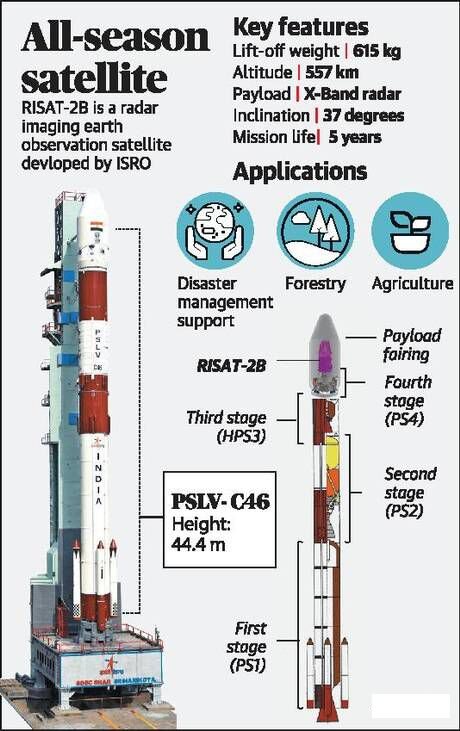
- The satellite has a mass of 615 kg and feature an X-band SAR (Synthetic Aperture Radar).
- It is built for a 5 year operational lifetime.
- RISAT 2B will be launched into a 37° inclined orbit at 555 km orbital height.
- RISAT 2B, RISAT 2BR1 and RISAT 2BR2 will be launched in 2019 on Indian PSLV launch vehicles.
Significance
- Regular remote-sensing or optical imaging satellites work like a light-dependent camera that cannot perceive hidden or surreptitious objects in cloudy or dark conditions.
- Satellites that are equipped with an active sensor, the synthetic aperture radar (SAR), can sense or ‘observe’ Earth in a special way from space day and night, rain or cloud.
- A radar imaging satellite is complex to assemble. Interpreting its images is equally complex.
- It will mark the resumption of a vital ring of Indian all-seeing radar imaging satellites after seven years.
- It will add to the reconnaissance capability from about 500 km in space. A constellation of such space-based radars means a comprehensive vigil over the country.
Applications
- In India radar imaging are used for crop estimation because our main crop growing season of kharif is in May-September when it rains and gets cloudy.
- We have used this data extensively for forestry, soil, land use, geology and during floods and cyclone.
- Due to an all-weather seeing feature, the satellite becomes special for security forces and disaster relief agencies.
Science & Technology
Evidence of Water Found at Ultima Thule
NASA has found evidence for a unique mixture of methanol, water, ice and organic molecules on Ultima Thule's surface
- NASA has published the first profile of Ultima Thule, an ancient relic from the era of planet formation revealing details about the complex space object.
- Researchers are investigating a range of surface features on Ultima Thule, such as bright spots and patches, hills and troughs, and craters and pits on it.
- The largest depression is a 8-kilometer-wide, the team has nicknamed Maryland crater, likely formed from an impact.
- Colour and composition: of Ultima Thule resembles many other objects found in its area of the Kuiper Belt. Its reddish hue is believed to be caused by modification of the organic materials on its surface.
About Ultima Thule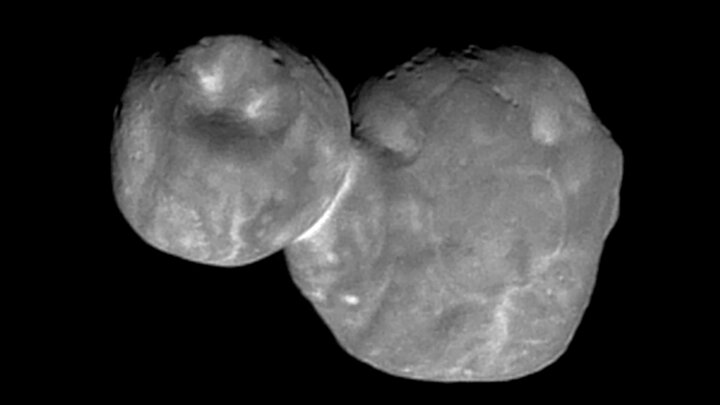
- NASA’s New Horizons spacecraft flew past the icy object nicknamed Ultima Thule (TOO-lee) in Kuiper belt.
- It is a contact binary, with two distinctly differently shaped lobes. It consists of a large, strangely flat lobe nicknamed "Ultima" connected to a smaller, somewhat rounder lobe dubbed "Thule" at a juncture.
- The lobes likely once orbited each other until some process brought them together in what scientists have shown to be a "gentle" merger.
- The alignment of the axes of Ultima and Thule indicates that before the merger the two lobes must have become tidally locked, meaning that the same sides always faced each other as they orbited around the same point.
The discoveries made about Ultima Thule are going to advance theories of solar system formation.
Social Justice
Measles Surge in Kerala
Background
The state of Kerala has been witnessing the serious surge in the incidence of Measles since January 2019. This is in conformity with current global resurgence in measles.
Key Points
- Kerala reports around 600+ cases of measles every year. This year, as many cases have been reported in the first four months itself.
- Historically, measles has been a childhood disease. The epidemiological shift to older population presents new public health challenges because of the increased severity of the disease, especially in vulnerable populations like pregnant women and immunocompromised patients (HIV, organ transplant recipients on immunosuppressants, cancer patients), who cannot be vaccinated with the live attenuated measles vaccine.
- When universal routine immunization in childhood improves and the virus is still in circulation, the disease will naturally move to the older age group who may be unimmunized or whose vaccine-derived immunity has begun to wane.
- The first vaccination age for measles has been fixed at nine months because till then, the maternal antibodies transferred in utero are supposed to afford protection to the child.
- As a part of the national measles elimination strategy, a mandatory second dose at 15-18 months was introduced in 2010, so that there is better immune protection.
- It is fairly certain that those currently in the 18-40 years age group have not had the protection of the second dose and may be one reason for the increase in cases in this age group.
- However, some cases of death of infants younger than nine months due to measles, are also reported as young mothers may not have sufficient antibody protection.
- The changing epidemiology of measles has not just brought forth the several unknowns but also raised important questions on whether adult immunization should be a policy, on vaccine potency, the adequacy of vaccine immune response and consideration of third dose of MMR (mumps-measles-rubella).
Indian Heritage & Culture
Golconda-Qutb Shahi Tombs
The National Monuments Authority (NMA) has given the go-ahead for the development of 54 row houses in the regulated zone of the 500-year-old Golconda Fort and Qutb Shahi Tombs Complex in Hyderabad (Telangana), with the caveat that colour scheme should match with that of the monuments.
- Department of Heritage, Telangana, raised multiple concerns citing Ancient Monuments and Archaeological Sites and Remains (AMASR) Act against the issue of no-objection certificate to the builder.
Concerns
- There is a concern that the construction will block the visual continuity that has existed for centuries between the two locations.
- The construction location is 101 metres beyond the wall near Patancheru Darwaza. The gate, in earlier times, used to be an important passage from the Inner Fort to the site of Old Golconda.
- The construction may impact the history of 'Old Golconda'. It is believed that the site of Old Golconda might have extended to the area of potential new construction between the fort and the tombs.
- It will impact the five small water bodies between the fort wall and the outer enclosure of tombs.
- The construction will also impact efforts for securing the World Heritage Status for the sites (2014 nomination).
Government agencies and citizens need to work together to retain the heritage character of the two sites.
The Ancient Monuments and Archaeological Sites and Remains AMASR (Amendment and Validation) Act, 2010
- The act that was passed in 2010 has the stated objective to preserve, conserve, protect and maintain all ancient monuments and archaeological sites and remains declared of national importance, and their surrounding areas up to a distance of 300 meters ( or more as may be specified in certain cases) in all directions.
- No construction or reconstruction is permitted in the prohibited area (an area up to a distance of 100 meters in all directions from the nearest protected limit of nearby protected monument or protected area declared as of national importance), but repair or renovation is considered.
- In the regulated area (an area up to a distance of 200 meters in all directions from the prohibited area of any protected monument and protected area declared as of national importance), repair/renovation/construction/reconstruction are considered.
- All applications for construction related work in the prohibited and regulated areas are to be submitted to the Competent Authorities (CA) and then to NMA for consideration.
National Monuments Authority (NMA)
- NMA under the Ministry of Culture has been setup as per the provisions of the Ancient Monuments and Archaeological Sites and Remains AMASR (Amendment and Validation) Act which was enacted in March,2010.
- Several functions have been assigned to the NMA for the protection and preservation of monuments and sites through management of the prohibited and regulated areas around the centrally protected monuments.
- NMA also considers grant of permissions to applicants for construction related activity in the prohibited and regulated areas.
Golconda Fort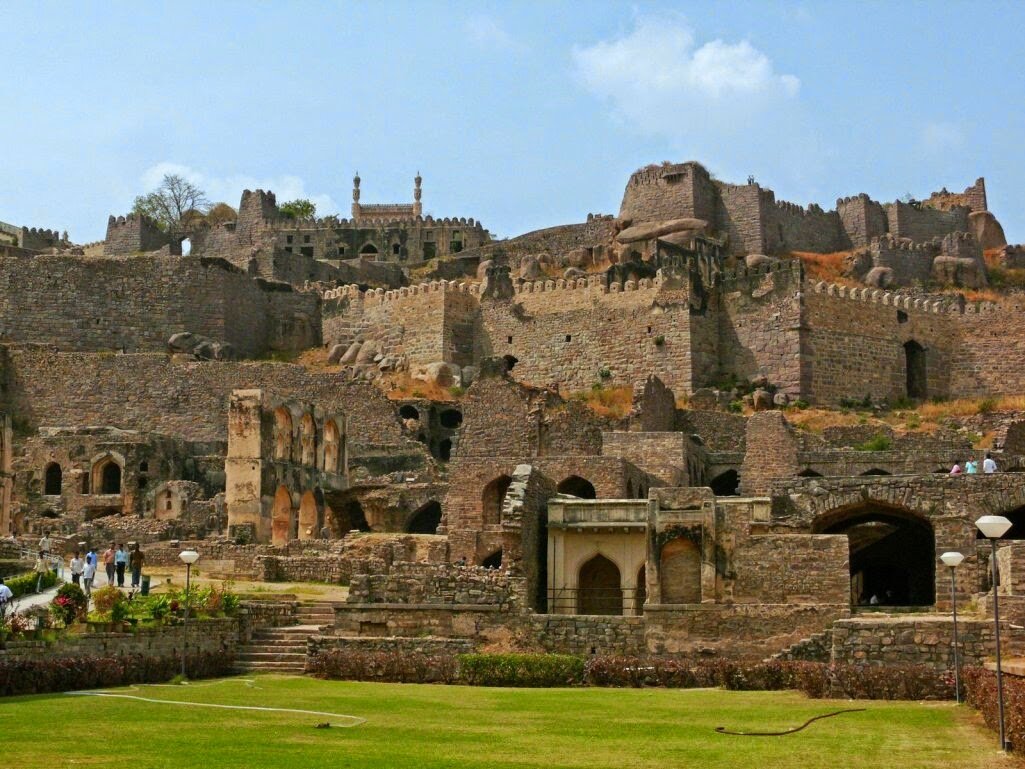
- It is located in the western part of Hyderabad city.
- It was originally known as Mankal, and built on a hilltop in the year 1143.
- It was originally a mud fort under the reign of Rajah of Warangal.
- Later it was fortified between 14th and 17th centuries by the Bahmani Sultans and then by the Qutub Shahi dynasty. Golconda was the principal capital of the Qutub Shahi kings.
- The inner fort contains ruins of palaces, mosques and a hilltop pavilion, which rises about 130 meters high and gives a bird’s eye view of other buildings.
Qutb Shahi Tombs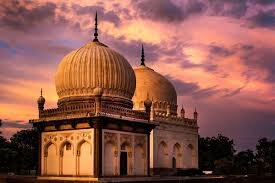
- Lying two kilometers from the Golconda Fort, the Qutb Shahi Tombs are built in Persian, Hindu and Pathani styles of architecture.
- The tombs were planned and built by numerous monarchs who ruled the state during the 18th century.
- The grandeur of the tombs is ensconced amidst the beautiful and picturesque landscape and gardens of Ibrahim Bagh, and the tombs themselves are dedicated to the seven Qutub Shahi kings who ruled Golconda for nearly 170 years.
- One of the most impressive tombs belongs to the founder of Hyderabad, Mohammed Quli Qutub Shah which rises to a height of 42 meters.
Important Facts For Prelims
Important Facts For Prelims (20th May 2019)
SIMBEX 2019
- The 26th edition of the annual Singapore India Maritime Bilateral Exercise, SIMBEX-2019, is being conducted in the South China Sea from 16th May to 22th May, 2019.
- In addition to Indian Navy ships Kolkata and Shakti, a long range maritime patrol aircraft Poseidon-8I (P8I) is participating in the SIMBEX-19.
- The bilateral exercise SIMBEX that was started in the year 1993 has grown in tactical and operational complexities and progressed from a basic anti-submarine exercise to a more complex maritime exercise which includes advanced air defence operations, anti-air, surface weapon firings and tactical exercises .
- In the year 2018, the exercise took place in the Indian Ocean, off the Andaman and Nicobar Islands.
Survey of Frugivore Birds
Recently, the Nature Conservation Foundation have mapped different frugivore (fruit eater) birds and their interactions that are important for the forest ecosystem.
- The study carried out in Pakke Tiger Reserve in Arunachal Pradesh and looked at 43 tree species and 48 frugivore bird species that were seen visiting them.
- The trees were classified into small, medium and large-seeded.
- The large-seeded trees mainly depended on hornbills and imperial pigeons for their dispersal.
- The medium-size seeded trees were visited by bulbuls, barbets along with hornbills and imperial pigeons. Though the frequency of visits was similar for all four bird species, the number of fruits removed from trees was high for hornbills.
- Hornbills, one among the large-sized frugivores, were the top seed dispersers and also the most threatened. They are hunted for meat, and the tribal communities use their feathers for headdresses.
- It was noted that, when the number of hornbills decreased in an area, the regeneration of large-seeded plants that were primarily dispersed from them was also affected.
- Bulbuls visited small and medium-sized seed trees in large numbers, they did not handle the seed well.
- Plants depend on frugivore birds to disperse the seeds at favourable sites, which have low competition and predation pressures, to expand their geographic range.
NOTE: The Nature Conservation Foundation is a non-governmental wildlife conservation and research organisation based in Mysore.

